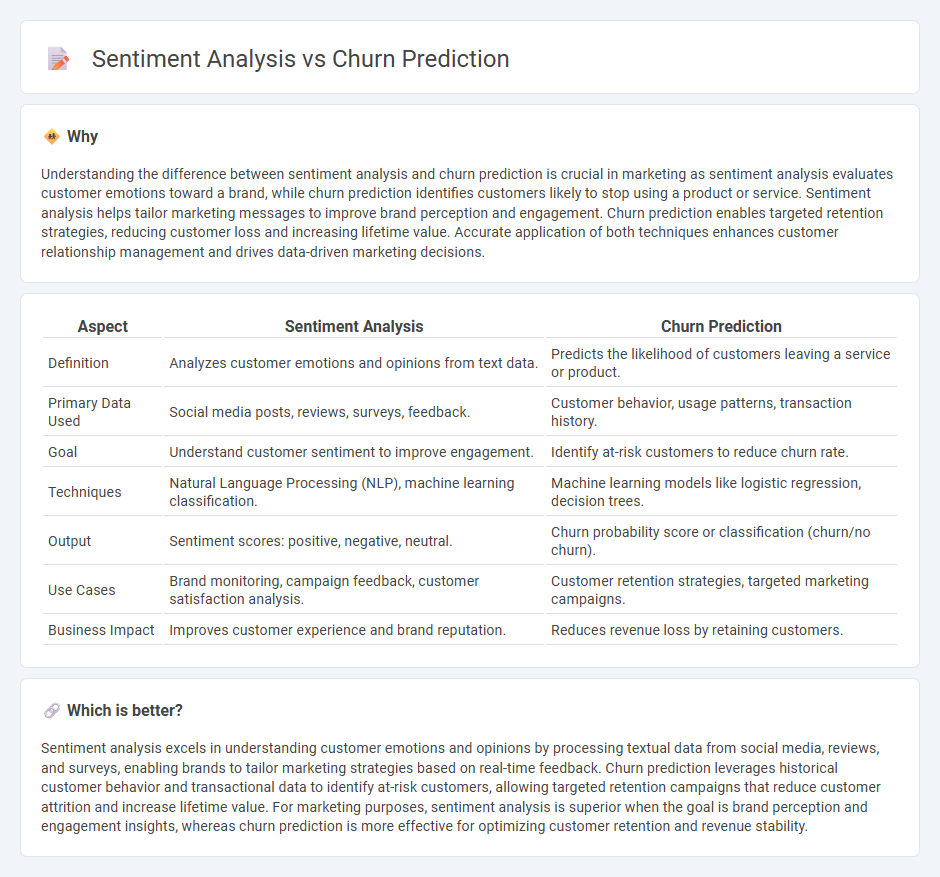
Sentiment analysis evaluates customer emotions and opinions from text data to understand brand perception and customer satisfaction. Churn prediction uses historical customer behavior and demographic data to identify individuals at risk of leaving a service or product. Discover how integrating sentiment analysis with churn prediction can enhance customer retention strategies.
Why it is important
Understanding the difference between sentiment analysis and churn prediction is crucial in marketing as sentiment analysis evaluates customer emotions toward a brand, while churn prediction identifies customers likely to stop using a product or service. Sentiment analysis helps tailor marketing messages to improve brand perception and engagement. Churn prediction enables targeted retention strategies, reducing customer loss and increasing lifetime value. Accurate application of both techniques enhances customer relationship management and drives data-driven marketing decisions.
Comparison Table
| Aspect | Sentiment Analysis | Churn Prediction |
|---|---|---|
| Definition | Analyzes customer emotions and opinions from text data. | Predicts the likelihood of customers leaving a service or product. |
| Primary Data Used | Social media posts, reviews, surveys, feedback. | Customer behavior, usage patterns, transaction history. |
| Goal | Understand customer sentiment to improve engagement. | Identify at-risk customers to reduce churn rate. |
| Techniques | Natural Language Processing (NLP), machine learning classification. | Machine learning models like logistic regression, decision trees. |
| Output | Sentiment scores: positive, negative, neutral. | Churn probability score or classification (churn/no churn). |
| Use Cases | Brand monitoring, campaign feedback, customer satisfaction analysis. | Customer retention strategies, targeted marketing campaigns. |
| Business Impact | Improves customer experience and brand reputation. | Reduces revenue loss by retaining customers. |
Which is better?
Sentiment analysis excels in understanding customer emotions and opinions by processing textual data from social media, reviews, and surveys, enabling brands to tailor marketing strategies based on real-time feedback. Churn prediction leverages historical customer behavior and transactional data to identify at-risk customers, allowing targeted retention campaigns that reduce customer attrition and increase lifetime value. For marketing purposes, sentiment analysis is superior when the goal is brand perception and engagement insights, whereas churn prediction is more effective for optimizing customer retention and revenue stability.
Connection
Sentiment analysis extracts customer emotions and opinions from text data, providing valuable insights into customer satisfaction and dissatisfaction. Churn prediction leverages these sentiment insights to identify at-risk customers by analyzing negative sentiments and behavioral patterns. Integrating sentiment analysis enhances churn prediction models, improving accuracy in forecasting customer attrition and enabling targeted retention strategies.
Key Terms
**Churn Prediction:**
Churn prediction leverages machine learning algorithms and customer data to identify patterns indicating potential customer attrition, enabling businesses to take proactive retention measures. Key data points include transaction history, customer service interactions, and engagement metrics, which help build accurate predictive models. Explore deeper insights into churn prediction techniques and tools to enhance customer loyalty and reduce turnover.
Retention Rate
Churn prediction analyzes customer behavior patterns to forecast the likelihood of customers leaving a service, directly impacting retention rate optimization. Sentiment analysis interprets customer emotions and opinions from feedback, enabling businesses to address concerns and enhance satisfaction, contributing indirectly to improved retention rates. Explore how integrating churn prediction and sentiment analysis can maximize your retention strategies and business growth.
Customer Lifetime Value (CLV)
Churn prediction models identify customers at risk of leaving, enabling targeted retention strategies directly boosting Customer Lifetime Value (CLV). Sentiment analysis evaluates customer opinions and satisfaction, providing qualitative insights that help tailor experiences to increase loyalty and overall CLV. Explore advanced methods to integrate churn prediction and sentiment analysis for maximizing your CLV.
Source and External Links
Mastering Churn Prediction: Strategies for Improved ... - Churn prediction models analyze historical customer data and behavioral signals to identify which customers are likely to stop using a product, enabling targeted actions like personalized onboarding and outreach to prevent churn.
Building a Churn Prediction Model - Churn prediction involves forecasting which customers might leave based on their behavior, allowing businesses to implement proactive retention strategies such as customer support outreach and targeted re-engagement campaigns.
Research on customer churn prediction and model ... - Advanced churn prediction models like GA-XGBoost, which combine genetic algorithms with machine learning techniques and address data imbalance with methods like SMOTEENN, have demonstrated high accuracy and interpretability in predicting customer churn.
 dowidth.com
dowidth.com